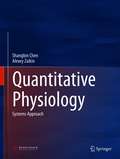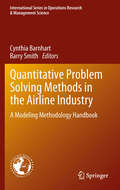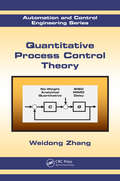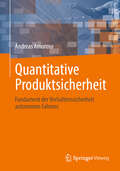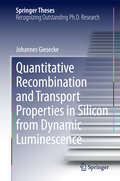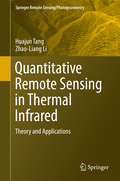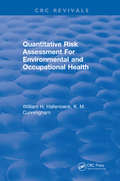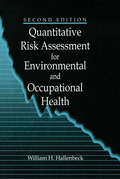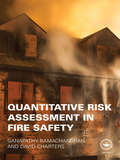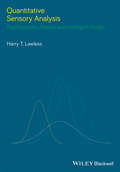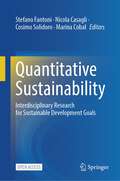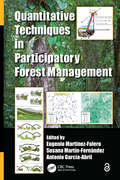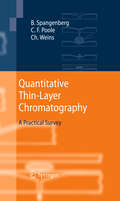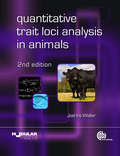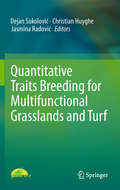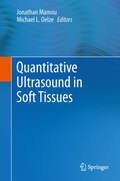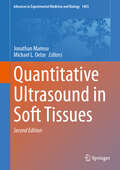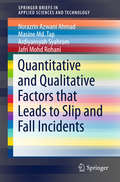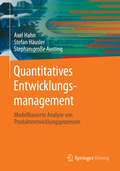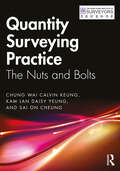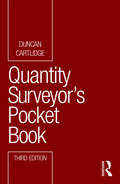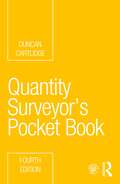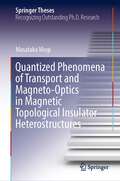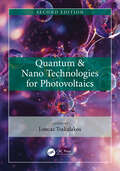- Table View
- List View
Quantitative Physiology: Systems Approach
by Shangbin Chen Alexey ZaikinStephen Hawking says that the 21st century will be the century of complexity and indeed now systems biology or medicine means dealing with complexity. Both the genome and physiome have emerged in studying complex physiological systems. Computational and mathematical modeling has been regarded as an efficient tool to boost the understanding about living systems in normal or pathophysiological states.Covering applied methodology, basic case studies and complex applications, this volume provides researchers with an overview of modeling and computational studies of physiology (i.e. quantitative physiology), which is becoming an increasingly important branch of systems biology.This book aims to build multi-scale models to investigate functions in living systems and explain how biomolecules, cells, organs, organ systems and organisms carry out the chemical or physical functions. Some of the models addressed are related to gene expression, calcium signalling, neural activity, blood dynamics and bone mechanics.Combining theory and practice, with extensive use of MATLAB, this book is designed to establish a paradigm for quantitative physiology by integrating biology, mathematics, physics and informatics etc. To benefit from this book, the readers are expected to have a background in general physiology and mathematics
Quantitative Problem Solving Methods in the Airline Industry
by Barry Smith Cynthia BarnhartThis book reviews Operations Research theory, applications and practice in seven major areas of airline planning and operations. In each area, a team of academic and industry experts provides an overview of the business and technical landscape, a view of current best practices, a summary of open research questions and suggestions for relevant future research. There are several common themes in current airline Operations Research efforts. First is a growing focus on the customer in terms of: 1) what they want; 2) what they are willing to pay for services; and 3) how they are impacted by planning, marketing and operational decisions. Second, as algorithms improve and computing power increases, the scope of modeling applications expands, often re-integrating processes that had been broken into smaller parts in order to solve them in the past. Finally, there is a growing awareness of the uncertainty in many airline planning and operational processes and decisions. Airlines now recognize the need to develop 'robust' solutions that effectively cover many possible outcomes, not just the best case, "blue sky" scenario. Individual chapters cover: Customer Modeling methodologies, including current and emerging applications. Airline Planning and Schedule Development, with a look at many remaining open research questions. Revenue Management, including a view of current business and technical landscapes, as well as suggested areas for future research. Airline Distribution -- a comprehensive overview of this newly emerging area. Crew Management Information Systems, including a review of recent algorithmic advances, as well as the development of information systems that facilitate the integration of crew management modeling with airline planning and operations. Airline Operations, with consideration of recent advances and successes in solving the airline operations problem. Air Traffic Flow Management, including the modeling environment and opportunities for both Air Traffic Flow Management and the airlines.
Quantitative Process Control Theory (ISSN)
by Weidong ZhangQuantitative Process Control Theory explains how to solve industrial system problems using a novel control system design theory. This easy-to-use theory does not require designers to choose a weighting function and enables the controllers to be designed or tuned for quantitative engineering performance indices such as overshoot.In each chapter, a s
Quantitative Produktsicherheit: Fundament der Verhaltenssicherheit autonomen Fahrens
by Andreas AmorosoDie Produktentwicklung autonomer Fahrsysteme erfordert die Lösung zweier Aufgaben: 1. Es muss eine erfolgversprechende Implementierung entwickelt werden. 2. Die Sicherheit derselben ist vor der Inverkehrbringung nachzuweisen. Voraussetzung zur Lösung der zweiten Aufgabe ist ein profundes Verständnis des großen Bereiches Produktsicherheit. Um dieses zu erschließen, werden erstmals sowohl eine geeignete Nomenklatur als auch eine Taxonomie vorgeschlagen. Diese bilden die Basis für weitergehende Betrachtungen zur Frage der Validierung von Produkten, die aufzeigen, dass die diesbezüglichen Möglichkeiten sehr eingeschränkt sind. Ausgehend von diesem Zwischenergebnis werden die Begriffe der quantitativen Verhaltens- und Produktsicherheit abgeleitet, welche nachweislich die alternativlose Basis jeglicher Sicherheitsargumentation autonomer Fahrzeuge bilden. Die erstgenannte Frage des Entwurfs erfolgversprechender Implementierungen wird bewusst ausgespart. Ihre Beantwortung bleibt einem zweiten Buch vorbehalten, das in Vorbereitung ist.
Quantitative Recombination and Transport Properties in Silicon from Dynamic Luminescence
by Johannes GieseckeHarmonically modulated luminescence combines the advantages of highly sensitive luminescence metrology with an immediate dynamic access to carrier lifetime in semiconductors at a minimum of required a priori information. The present work covers theoretical, conceptual, and experimental advances of the harmonically modulated luminescence technique. Theoretical constraints of dynamic carrier lifetime techniques are rigorously elaborated, including the proof of their differential nature and their characteristics at nonuniform spatial distributions of recombination rate. The pathway toward a unified, reliable, and versatile harmonically modulated carrier lifetime metrology is delineated - covering the entire solar cell production chain from bare ingots to finished solar cells. Accurate access to miscellaneous relevant recombination and transport properties via harmonically modulated luminescence is demonstrated and experimentally validated, embracing injection-dependent carrier lifetimes at extremely low injection conditions, a spatially resolved carrier lifetime calibration of luminescence images, and accurate approaches to both net dopant concentration and minority carrier mobility.
Quantitative Remote Sensing in Thermal Infrared
by Huajun Tang Zhao-Liang LiThis book provides a comprehensive and advanced overview of the basic theory of thermal remote sensing and its application in hydrology, agriculture, and forestry. Specifically, the book highlights the main theory, assumptions, advantages, drawbacks, and perspectives of these methods for the retrieval and validation of surface temperature/emissivity and evapotranspiration from thermal infrared remote sensing. It will be an especially valuable resource for students, researchers, experts, and decision-makers whose interest focuses on the retrieval and validation of surface temperature/emissivity, the estimation and validation of evapotranspiration at satellite pixel scale, and the application of thermal remote sensing. Both Prof. Huajun Tang and Prof. Zhao-Liang Li work at the Chinese Academy of Agricultural Sciences (CAAS), China.
Quantitative Remote Sensing: Fundamentals and Environmental Applications
by Jay GaoThis book provides comprehensive and in-depth explanations of all topics related to quantitative remote sensing and its applications in terrestrial, biospheric, hydrospheric, and atmospheric studies. It elucidates how to retrieve quantitative information on a wide range of environmental parameters from various remote sensing data at the highest accuracy possible and expounds how different aspects of the target of remote sensing can be quantified using diverse analytical methods and level of accuracy. Written in an easy-to-follow language, logically organized, and with step-by-step examples, the book assists readers to deepen their understanding of the theory and cutting-edge research on quantitative remote sensing. Features Explains how to retrieve quantitative information on a wide range of environmental parameters from various tailored remote sensing data at the highest accuracy possible. Manifests the author's decades of teaching and research in quantitative remote sensing and approaches the subject from both theoretical and pragmatic perspectives, informed by the latest research outcomes. Includes practical and real-life examples to illustrate how the quantitative information on a target can be retrieved from a given type of remote sensing data. Focuses on the latest developments in the field of quantitative remote sensing. Introduces sufficient mathematical concepts to reveal how remotely sensed data are converted to quantitative information while providing quality assurance of the retrieved results. This is a suitable textbook for upper-level undergraduate or postgraduate students and serves as a handy and valuable reference for professionals working in monitoring the environment. By reading this book, readers gain a sound understanding of how to retrieve quantitative information on the environment from diverse remote sensing data using the most appropriate cutting-edge methods and software.
Quantitative Risk Assessment for Environmental and Occupational Health
by William H. HallenbeckMany individuals and groups need a usable treatment of the methodology required to assess the human health risks caused by toxicant exposure. This need is shared by industrial hygienists, environmental, occupational and public health professionals, toxicologists, epidemiologists, labor unions, attorneys, regulatory officials, and manufacturers and users of chemicals. The reader needs only a basic knowledge of biology adn algebra in order to utilize the methodology presented. In addition, a basic knowledge of toxicology, epidemiology, and statistics is derisrable for a full understanding of some aspects of risk assessment. Sophisticated computer programs are not required. All the computations can be carried out with a pocked calculator.
Quantitative Risk Assessment for Environmental and Occupational Health
by William H. HallenbeckQuantitative Risk Assessment for Environmental and Occupational Health, Second Edition features twice as many risk analysis models with complete examples as the previous edition. The book features new information in the following areas:Calculation of human dose rate and dose from experimental studies (animal and human) Quantitat
Quantitative Risk Assessment in Fire Safety
by Ganapathy Ramachandran David ChartersFire safety regulations in many countries require Fire Risk Assessment to be carried out for buildings such as workplaces and houses in multiple occupation. This duty is imposed on a "Responsible Person" and also on any other persons having control of buildings in compliance with the requirements specified in the regulations. Although regulations only require a qualitative assessment of fire risk, a quantitative assessment is an essential first step for performing cost-benefit analysis of alternative fire strategies to comply with the regulations and selecting the most cost-effective strategy. To facilitate this assessment, various qualitative, semi-quantitative and quantitative techniques of fire risk assessment, already developed, are critically reviewed in this book and some improvements are suggested. This book is intended to be an expanded version of Part 7: Probabilistic risk assessment, 2003, a Published Document (PD) to British Standard BS 7974: 2001 on the Application of Fire Safety Engineering Principles to the Design of Buildings. Ganapathy Ramachandran and David Charters were co-authors of PD 7974 Part 7. Quantitative Risk Assessment in Fire Safety is essential reading for consultants, academics, fire safety engineers, fire officers, building control officers and students in fire safety engineering. It also provides useful tools for fire protection economists and risk management professionals, including those involved in fire insurance underwriting.
Quantitative Sensory Analysis: Psychophysics, Models and Intelligent Design
by Harry T. LawlessSensory evaluation is a scientific discipline used to evoke, measure, analyse and interpret responses to products perceived through the senses of sight, smell, touch, taste and hearing. It is used to reveal insights into the way in which sensory properties drive consumer acceptance and behaviour, and to design products that best deliver what the consumer wants. It is also used at a more fundamental level to provide a wider understanding of the mechanisms involved in sensory perception and consumer behaviour. Quantitative Sensory Analysis is an in-depth and unique treatment of the quantitative basis of sensory testing, enabling scientists in the food, cosmetics and personal care product industries to gain objective insights into consumer preference data – vital for informed new product development. Written by a globally-recognised learer in the field, this book is suitable for industrial sensory evaluation practitioners, sensory scientists, advanced undergraduate and graduate students in sensory evaluation and sensometricians.
Quantitative Sustainability: Interdisciplinary Research for Sustainable Development Goals
by Nicola Casagli Stefano Fantoni Cosimo Solidoro Marina CobalThis open access book focuses on how scientific methodologies can help industrial managers, entrepreneurs and policymakers handle the 17 Sustainable Development Goals in an efficient and realistic way. It also offers an operative scheme for scientists to overcome their discipline barriers. Is interdisciplinarity an intrinsic research value or is it merely instrumental for handling the increasing flux of open problems that sustainability poses to science?Can these problems of sustainability be solved with what the authors already know? Is it just a matter of having the right people at the table and giving them sufficient resources, or is it something more? Is meeting the needs of the present without compromising those of future generations a scientific definition of sustainable development? Questions similar to those posed in the sixties regarding complexity must be asked about sustainability today. In addition, the new data science includes powerful tools for making novel quantitative predictions about future sustainability indicators, an open problem that the book discusses. This book is primarily addressed to Ph.D. students, postdocs and senior researchers in the Life and Hard Science (LHS) and Social Sciences and Humanities (SSH) disciplines, as well as professionals of the primary, secondary and tertiary industrial sectors.
Quantitative Techniques in Participatory Forest Management
by Eugenio Martínez-FaleroForest management has evolved from a mercantilist view to a multi-functional one that integrates economic, social, and ecological aspects. However, the issue of sustainability is not yet resolved. Quantitative Techniques in Participatory Forest Management brings together global research in three areas of application: inventory of the forest variables that determine the main environmental indices, description and design of new environmental indices, and the application of sustainability indices for regional implementations. All these quantitative techniques create the basis for the development of scientific methodologies of participatory sustainable forest management.
Quantitative Thin-Layer Chromatography
by Bernd Spangenberg Colin F. Poole Christel WeinsThin-layer chromatography (TLC) is widely used particularly for pharmaceutical and food analysis. While there are a number of books on the qualitative identification of chemical substances by TLC, the unique focus here is on quantitative analysis. The authors describe all steps of the analytical procedure, beginning with the basics and equipment for quantitative TLC followed by sample pretreatment and sample application, development and staining, scanning, and finally statistical and chemometric data evaluation and validation. An important feature is the coverage of effect-directed biological detection methods. Chapters are organized in a modular fashion facilitating the easy location of information about individual procedural steps.
Quantitative Trait Loci Analysis in Animals (2nd edition)
by Joel Ira WellerThis text for graduate students and researchers in quantitative genetics and animal breeding discusses the detection of quantitative trait loci (QTL) in animals. Following a historical overview of the field, Weller (Institute of Animal Sciences, Israel) describes methods for QTL detection and analysis and marker assisted selection, especially those pertaining to agricultural animal species.
Quantitative Traits Breeding for Multifunctional Grasslands and Turf
by Dejan Sokolović Christian Huyghe Jasmina RadovićGrasslands are among the largest ecosystems in the world and consequently are of great importance to mankind. The genotypes of the species which are the main components of the grasslands have great influence on total outcome and successful utilization of grasslands. Therefore fodder crops and turf swards should be constantly improved to follow modern trends in agriculture production and landscape architecture. The wide range of breeding programs for forage and amenity species, as well as new breeding methods and techniques, is rapidly expanding the boundaries and is making it possible to achieve outstanding breeding results. This book includes papers presented at the 30th EUCARPIA Fodder Crops and Amenity Grasses Section Meeting. The challenging title of the book focuses on breeding of quantitative traits, which directly impact the profitability and sustainability of grasslands and fodder crops production, as well as on multidisciplinary approach in grassland research and utilisation. Included papers offer a unique collection of ideas and breakthroughs in the fields of fodder crops and amenity grasses breeding and genetics, as well as in the creative and innovative application of new tools in practical breeding.
Quantitative Ultrasound in Soft Tissues
by Jonathan Mamou Michael L. OelzeDue to parallel advances in signal processing and computer hardware in the last 15 years, quantitative ultrasound techniques have reached maturity, allowing for the construction of quantitative maps or images of soft tissues. This book will focus on 5 modern research topics related to quantitative ultrasound of soft tissues: - Spectral-based methods for tissue characterization, tissue typing, cancer detection, etc. ; - Envelope statistics analysis as a means of quantifying and imaging tissue properties; - Ultrasound elastography for quantifying elastic properties of tissues (several clinical ultrasound scanners now display elastography images); - Scanning acoustic microscopy for forming images of mechanical properties of soft tissues with micron resolution (desktop size scanners are now available); and - Ultrasound computer tomography for breast cancer imaging (new ultrasound tomography systems have been developed and are currently under evaluation clinically).
Quantitative Ultrasound in Soft Tissues (Advances in Experimental Medicine and Biology #1403)
by Jonathan Mamou Michael L. OelzeQuantitative ultrasound (QUS) continues to mature as a research field and is primed to make a swift transition to routine preclinical and clinical applications. This book will serve two main purposes: Advanced education in QUS by providing a complete and thorough review of all theoretical, physical, and engineering aspects of QUS.Review of recent development of QUS by lead contributors in the research field. This 2nd edition will focus on 6 modern research topics related to quantitative ultrasound of soft tissues: Spectral-based methods for tissue characterization, tissue typing, cancer detection, etc.Attenuation estimation for tissue characterization and improving spectral based methodsEnvelope statistics analysis as a means of quantifying and imaging tissue properties.Ultrasound computed tomography for preclinical and clinical imaging.Scanning acoustic microscopy for forming images of mechanical properties of soft tissues with micron resolution.Phantoms for quantitative ultrasound.
Quantitative and Qualitative Factors that Leads to Slip and Fall Incidents
by Ardiyansyah Syahrom Norazrin Azwani Ahmad Masine Md. Tap Jafri Mohd RohaniThis book investigates the factors that lead to slip and fall incidents and establishes a relationship between the coefficient of friction (COF), floor slipperiness and floor roughness. It also examines human perception of slipperiness through measured coefficient of friction (COF). On the basis of questionnaire surveys among manufacturing workers, it identifies potential risk factors and assesses human perceptions of slipperiness. It also uses a tribology approach to relate the interaction between contaminants, floor and footwear materials.
Quantitatives Entwicklungsmanagement
by Axel Hahn Stephan Große Austing Stefan HäuslerDie Produktentwicklung ist der dynamischste und am schwersten zu beherrschende Prozess in Industrieunternehmen. Prozessreifegradmodelle wie CMMI erfordern dazu quantitative Methoden als Werkzeug des Entwicklungsmanagements. Mit der modellgetriebenen Entwicklung steht eine Datenbasis für eine durchgehende quantitative Analyse zur Verfügung. Modellanalysen erlauben eine prozessbegleitende Qualitätsmessung und die Bestimmung der Produktkomplexität und des Entwicklungsfortschritts. Das Buch stellt bestehende Methoden des quantitativen Entwicklungsmanagements zur Entscheidungsunterstützung auf operativer und strategischer Ebene vor. Die Autoren zeigen, wie die modellgetriebene Entwicklung zur Analyse der erreichten Ergebnisse genutzt werden kann, etwa zur Bewertung von Methoden, Werkzeugen sowie zur Prozess- oder Projektanpassung.
Quantity Surveying Practice: The Nuts and Bolts
by Sai On Cheung Chung Wai Keung Kam Lan YeungQuantity Surveying Practice: The Nuts and Bolts is a practical guide to quantity surveying in building construction. Due to the increasing expectations of quality and performance from project clients, quantity surveyors must improve their professional skills to solve a variety of intricate problems and disputes confronting the demanding construction market. This practical book focuses on the basic concepts underlying the technical aspects of quantity surveying and contains many worked examples together with useful figures and real-life cases to help readers digest and understand the essentials and become better professionals as a result. This book is organised and structured into seven chapters. Chapter 1 is about the estimation of construction costs. Chapter 2 gives an overview of tendering and tender documentation. Chapter 3 examines the procedure of tender examination and the approach to contract award. Chapter 4 reviews the whole process of an interim valuation from the submission of a payment application by the contractor to the issuance of an interim valuation by the quantity surveyor, identifying the key issues within the process. Chapter 5 examines the topic of construction claims. Chapter 6 addresses the cost control and monitoring in connection with construction projects. Chapter 7 is about dispute management and three commonly used dispute resolution mechanisms, namely mediation, adjudication and arbitration are introduced. This book is essential reading for students on quantity surveying and construction management programmes, as well as the APC candidates pursuing the professional quantity surveying pathway. It is also a useful reference for practicing quantity surveyors.
Quantity Surveyor's Pocket Book
by Duncan CartlidgeThe third edition of the Quantity Surveyor’s Pocket Book has been updated in line with NRM1, NRM2 and NRM3, and remains a must-have guide for students and qualified practitioners. Its focused coverage of the data, techniques and skills essential to the quantity surveying role makes it an invaluable companion for everything from initial cost advice to the final account stage. Key features and updates included in this new edition: an up-to-date analysis of NRM1, 2 and 3; measurement and estimating examples in NRM2 format; changes in procurement practice; changes in professional development, guidance notes and schemes of work; the increased use of NEC3 form of contract; the impact of BIM. This text includes recommended formats for cost plans, developer’s budgets, financial reports, financial statements and final accounts. This is the ideal concise reference for quantity surveyors, project and commercial managers, and students of any of the above.
Quantity Surveyor's Pocket Book (Routledge Pocket Books)
by Duncan CartlidgeThe fourth edition of Quantity Surveyor’s Pocket Book remains a must-have guide for students and qualified practitioners. Its focused coverage of the data, techniques and skills essential to the quantity surveying role makes it an invaluable companion for everything from initial cost advice to the final account stage. Key features and updates included in this new edition are as follows: The impact of Brexit on construction and public procurement; New developments in digital construction; Renewed focus on ethics in the industry; Up-to-date analysis of NRM1, 2 and 3; Latest practice guidance notes and government publications; Post-contract administration; A companion website with alternative approaches to taking off quantities using spreadsheets. This text includes recommended formats for cost plans, developer’s budgets, financial reports, financial statements and final accounts. This is the ideal concise reference for quantity surveyors, project and commercial managers, and students of any of the above.
Quantized Phenomena of Transport and Magneto-Optics in Magnetic Topological Insulator Heterostructures (Springer Theses)
by Masataka MogiThis book presents experimental studies on emergent transport and magneto-optical properties in three-dimensional topological insulators with two-dimensional Dirac fermions on their surfaces. Designing magnetic heterostructures utilizing a cutting-edge growth technique (molecular beam epitaxy) stabilizes and manifests new quantization phenomena, as confirmed by low-temperature electrical transport and time-domain terahertz magneto-optical measurements. Starting with a review of the theoretical background and recent experimental advances in topological insulators in terms of a novel magneto-electric coupling, the author subsequently explores their magnetic quantum properties and reveals topological phase transitions between quantum anomalous Hall insulator and trivial insulator phases; a new topological phase (the axion insulator); and a half-integer quantum Hall state associated with the quantum parity anomaly. Furthermore, the author shows how these quantum phases can be significantly stabilized via magnetic modulation doping and proximity coupling with a normal ferromagnetic insulator. These findings provide a basis for future technologies such as ultra-low energy consumption electronic devices and fault-tolerant topological quantum computers.
Quantum & Nano Technologies for Photovoltaics
by Loucas TsakalakosOngoing concerns regarding greenhouse gas-related environmental effects, energy security, and the rising costs of conventional energy sources has led to sustained interest and growth in solar energy in general, and photovoltaics in particular. Exploring state-of-the-art developments from a practical point of view, Quantum and Nanotechnology for Photovoltaics is the second edition of the book and examines issues in increasing efficiency, decreasing costs, and how these two goals can be achieved in a single photovoltaic device leveraging emergent quantum and nanoscale phenomena.The book provides fundamental background, including new chapters on quantum physics, hot carrier solar cells, luminescent solar concentrators, and additional topics, and places research approaches within the proper physical context as related to photovoltaics performance enhancement. It reviews the applications of devices and their performance requirements, followed by coverage of thin films and advanced band structure concepts for obtaining efficiencies above the Shockley–Queisser single band-gap efficiency limit of 31%. The editor and contributors also discuss the basic optical properties of nanostructured materials as related to photovoltaics applications and describes quantum hot-carrier device physics related to performance. They then explore recent literature in the application of various classes of nanostructures to photovoltaics. The book covers solar cells based on hybrid organic-inorganic nanocomposites structures, quantum wells, nanowires/tubes, and quantum dots. It also discusses the use of nanoparticles/quantum dots to enhance the performance of conventional solar cells and quantum-enhanced luminescent solar concentrators.Each chapter summarizes the historical development for the nanostructure class under consideration, applications beyond photovoltaics, and the major synthetic methods, followed by a critique of leading works that have employed the particular quantum and/or nanostructure type. The book examines the advantages of each quantum/nanostructure approach and the remaining technical challenges, with an emphasis on possible future areas of research interest. This work is intended for academic and industrial researchers developing new photovoltaic technologies, primarily at the graduate level and beyond, though senior-level undergraduates with appropriate training in physics and materials science will also benefit from this book. Many of the chapters also constitute useful background knowledge for managers and decision-makers in companies developing advanced photovaltaic, energy, and materials technologies.
